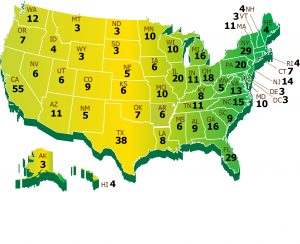Established in 1787, the Electoral College is mechanism utilized by the United States government during its election process. Consisting of 538 elected members of Congress, the Electoral College is comprised of 100 state senators, 435 members of the House of Representatives, and 3 representatives from Washington D.C as mandated by the 23rd amendment. With 2 senators per state, the other 438 representatives are allocated to states based on population.
Serving as representatives for their constituents, the members of the Electoral College cast their vote for president based off their district. Citizens cast their vote for one of the candidates running for President, with a winner take all rule based off of who has more votes in that district. Once the votes are in, the candidate with the most votes is awarded this district in all states besides Maine and Nebraska. The representative from this state are then awarded to that candidate, meaning they are responsible for using their vote to vote for the candidate who won their state. In order for a candidate to win the presidential election they must receive at least 270 Electoral College votes, which is one more than half of the votes.Despite the outcome, members of the Electoral College are entitled to request a change in their vote to go against their district and state winner, which will then be voted on by the rest of Congress.
Although the popular vote serves as total count of how many votes each candidate personally received, the electoral college acts as an override. Serving as representatives for the United State citizen, the Electoral College is the sole group that will directly elect the President elect for the upcoming term. Due to the allocation of representatives, a candidate who loses the popular vote and has fewer total votes can still win the election by winning states that are worth more votes.
